THE HISTORY OF THE GOR VIADUCT
Many thanks to Antonio Burgos Núñez and Juan Antonio Díaz Sánchez, University of Granada.
The early days
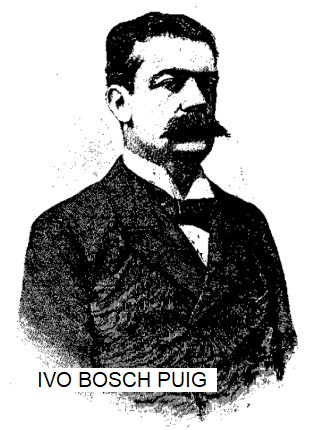 In 1894 The GSSR were having trouble financially and it was obvious that they wouldn't be able to finish the line between Baza and Granada.
In 1894 The GSSR were having trouble financially and it was obvious that they wouldn't be able to finish the line between Baza and Granada.
A little bit of background: The Granada Railway Company Ltd. was incorporated in London on 16th November 1894 with a nominal capital of £300,000 (£40 million at today's rates). The Spanish Railways Trust formed on 27th July 1894, (ROs 8/8/1894 and 3/12) which was transferred to the Compañia de Caminos de Hierro de Sur de España under Ivo Bosch Puig (Barcelona 1852 - 1915).
In 1895 the Compañia de Caminos de Hierro de Sur de España resolved its lawsuit between Fives-Lille that had continued since 1890.
Construction of the line started some time after 1895 but due to technical problems it didn't open until 1907.
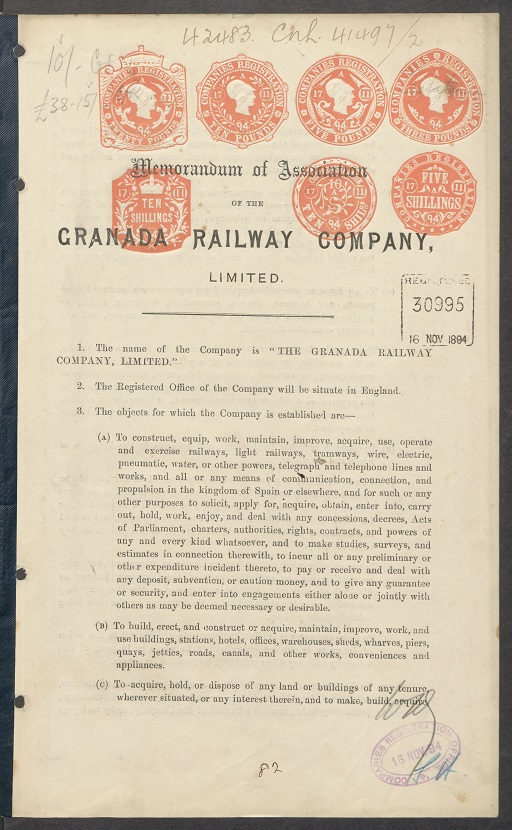 The GSSR wanted to pass the section between Guadix and Baza to The Granada Railway Company Ltd. but were unsuccessful in this. Finally, this section of track became part of the Compañia de Caminos de Hierro de Sur de España but using The GSSR's plans.
The GSSR wanted to pass the section between Guadix and Baza to The Granada Railway Company Ltd. but were unsuccessful in this. Finally, this section of track became part of the Compañia de Caminos de Hierro de Sur de España but using The GSSR's plans.
Eventually, The Granada Railway Co. Ltd. became a Spanish anonymous company called Compañia de Caminos de Hierro de Granada employing Ivo Bosch Puig who was the force behind the company as well as the main shareholder.
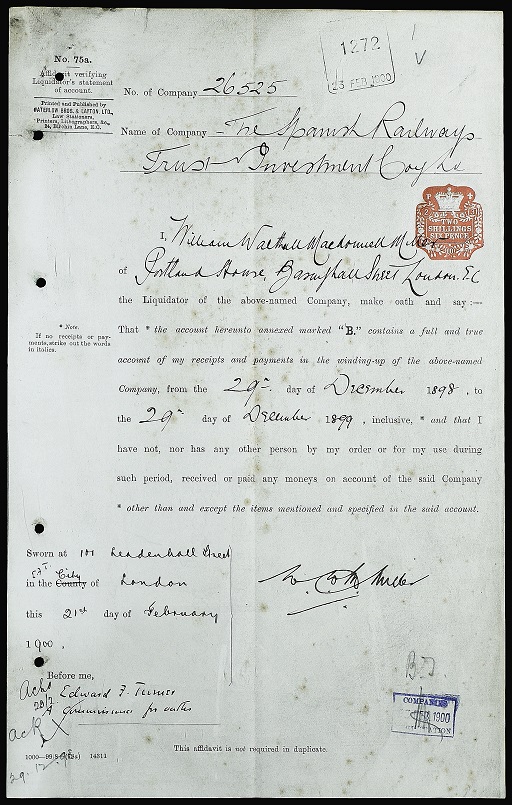 He eventually, 20 years later, signed documents for the control by Compañia de Caminos de Hierro de Sur de España of the section between Guadix and Baza and it can be seen in old plans that the engineers of Compañia de Caminos de Hierro de Sur de España were the same as The Granada Railway.
He eventually, 20 years later, signed documents for the control by Compañia de Caminos de Hierro de Sur de España of the section between Guadix and Baza and it can be seen in old plans that the engineers of Compañia de Caminos de Hierro de Sur de España were the same as The Granada Railway.
In 1903 - 4 The Granada Railway Company Ltd. was oficially responsible for the Guadix-Baza section which in the terms of the original contracts should have opened in 1895. Due to government prevarication and technical difficulties, the construction of this section of the line was terribly delayed. In 1900, in the absence of any further deferments, and with the possibility of losing what they had already invested in the project, the company had to start construction.
A Royal Order of 1902 gave permission for the construction with a limit of three years to complete and put into service this section.
The British concession started work with diligence, supported by The Compañia de Caminos de Hierro de Sur de España, and apart from the viaduct which is the subject of this article, all work was finished on time.
On this section there were four points where bridges were needed: El Grao (El Grado) (50m), Baúl (150m), Rambla Balatos (200m) and the viaduct at Gor (250m).
The engineer of tracks, Rafael de la Escosura was responsible for this section. His work was essentially to review the original plans (by The GSSR), making changes wherever needed. This work was completed before 1904.
The rest of the construction such as station buildings etc. were the responsibility of Fernández de la Escosura.
The first bridge
The primary project of The GSSR line from Granada to Murcia included a project for the construction of a viaduct across the River Gor which would have been one of the most original designs in all of Spain.
All that appears to exist nowadays are the original plans which bear the signature of Neil Kennedy, who was Hett, Maylor & Co. Ltd.'s solicitor.
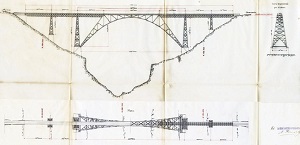 It is very likely that the industrial architect responsible for the original plans was James Livesey (who was also involved with the design of Serón, Almanzora and Zurgena stations and El Hornillo, and who had worked in Spain between 1857 and 1862 on the railway line between Santander and Alar del Rey). He was a specialist in railway construction and had studied in the USA as well as working extensively in South America. There is some information that he was responsible for the whole Murcia-Granada project but officially he was only responsible for the Almendricos-El Hornillo project.
It is very likely that the industrial architect responsible for the original plans was James Livesey (who was also involved with the design of Serón, Almanzora and Zurgena stations and El Hornillo, and who had worked in Spain between 1857 and 1862 on the railway line between Santander and Alar del Rey). He was a specialist in railway construction and had studied in the USA as well as working extensively in South America. There is some information that he was responsible for the whole Murcia-Granada project but officially he was only responsible for the Almendricos-El Hornillo project.
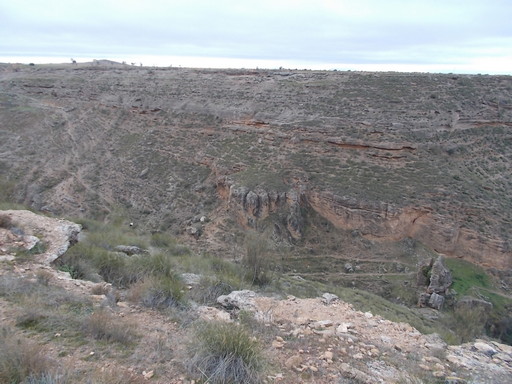 The original site for the viaduct was 8km to the north of where it was eventually built, where the land down to the river is very steep and where there would have been a main span of 135m, the full length of the viaduct being 235m. The plans for this viaduct were created by James Livesey in 1890.
The original site for the viaduct was 8km to the north of where it was eventually built, where the land down to the river is very steep and where there would have been a main span of 135m, the full length of the viaduct being 235m. The plans for this viaduct were created by James Livesey in 1890.
Due to the fact that all construction on this section was suspended for some years, when the time came to review the plans, it was decided in light of new information, that a less daring approach should be investigated. When the time came for actual construction of the line from Baza to Guadix, the Compañia de Caminos de Hierro de Sur de España took full responsibility. This is visible in the technical plans. The Granada Railway Co. Ltd. had Juan Cervantes Pinelo as administrating engineer who, in 1886, occupied the same position in Compañia de Caminos de Hierro de Sur de España, and in addition all of the technicians responsible for the viaduct (excepting Rafael de la Escosura) had been employees of Compañia del Sur.
The actual viaduct
At this time Juan Cervantes, José Moreno Ossorio, the frenchman Stanislav Basinsky (ex director of Fives-Lille during the construction of Linares-Almería line) and Silvestre Fernández de la Somera (ex-director of Guadix-Baza) formed part of a competent technical team that had previously built exceptional viaducts on the Linares-Almería and Granada-Moreda lines.
It is reasonable to assume that it was this team that designed the viaduct and presented the plans in 1904 although they are only signed by Cervantes as the administrator of The Granada Railway Co. Ltd.
 The new project was a total break from the original plan by James Livesey which Compañia de Caminos de Hierro de Sur de España didn't feel were ideal. The company tended to lean towards French designs such as those that use straight beams as can be seen on the Linares-Almería line. It was inevitable that the site was changed so as to site the viaduct closer to Gor making the crossing shorter and shallower.
The new project was a total break from the original plan by James Livesey which Compañia de Caminos de Hierro de Sur de España didn't feel were ideal. The company tended to lean towards French designs such as those that use straight beams as can be seen on the Linares-Almería line. It was inevitable that the site was changed so as to site the viaduct closer to Gor making the crossing shorter and shallower.
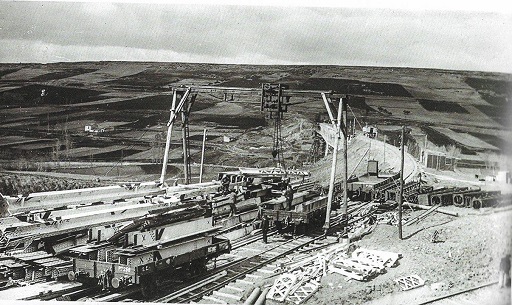 There was another plan for a viaduct with four spans but it didn't get past the pre-project stage. Rafael de la Escosura, who wrote to explain why the final plan was chosen said: "to build the viaduct of Gor, considering the bad conditions in which we find the ground for the placement of the footings, we have substituted the plan for four spans for one of only three spans which will allow us to place the footings in the most favourable places". This decision was to determine the design of the viaduct. With one less support, it followed the usual system of continuous beams. They had to come up with a solution that had never been used in Spain, namely "one of those called bridge-crane, bridge-console or cantilever, made of two distinct supports each one placed on a base extending further away from the base in the form of a corbel and supporting these spans a central span of 39.88m"; and in this way all spans comprised "a structure with the spans in the form of a continuous span without the inconveniences". Essentially, what he was suggesting was two spans that would be independent of each other from the point of view of load, as can be seen in the Forth Bridge. This created a viaduct with a span of 210m.
There was another plan for a viaduct with four spans but it didn't get past the pre-project stage. Rafael de la Escosura, who wrote to explain why the final plan was chosen said: "to build the viaduct of Gor, considering the bad conditions in which we find the ground for the placement of the footings, we have substituted the plan for four spans for one of only three spans which will allow us to place the footings in the most favourable places". This decision was to determine the design of the viaduct. With one less support, it followed the usual system of continuous beams. They had to come up with a solution that had never been used in Spain, namely "one of those called bridge-crane, bridge-console or cantilever, made of two distinct supports each one placed on a base extending further away from the base in the form of a corbel and supporting these spans a central span of 39.88m"; and in this way all spans comprised "a structure with the spans in the form of a continuous span without the inconveniences". Essentially, what he was suggesting was two spans that would be independent of each other from the point of view of load, as can be seen in the Forth Bridge. This created a viaduct with a span of 210m.
 Because the instability of the land was known from the beginning, it became a large factor in the design of the viaduct. As well as the choice of a cantilever system, the footings were designed with the instability of the land in mind. Normally one would build masonry supports but because of the land, much lighter steel lattice supports were chosen.
Because the instability of the land was known from the beginning, it became a large factor in the design of the viaduct. As well as the choice of a cantilever system, the footings were designed with the instability of the land in mind. Normally one would build masonry supports but because of the land, much lighter steel lattice supports were chosen.
The steelwork was angle iron, double-T, and other profiles of laminated iron joined with rivets. The span comprised triangular beams linked by X-shaped cross members and vertical stanchions.
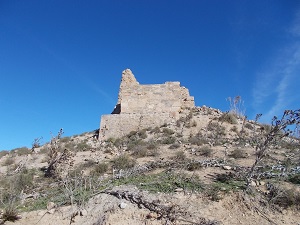 In addition, the viaduct had two large stonework bases of some 20m in height. In the project minor details regarding the stonework of the bases were not included, solely that they would be built on top of a base of concrete of hydraulic lime. The final plans were left for the future saying "of the foundations, there will be detailed projections when the conditions of the land are known".
In addition, the viaduct had two large stonework bases of some 20m in height. In the project minor details regarding the stonework of the bases were not included, solely that they would be built on top of a base of concrete of hydraulic lime. The final plans were left for the future saying "of the foundations, there will be detailed projections when the conditions of the land are known".
The viaduct at this point followed the recently written 'Instructions for Metal Bridges' of 1902. However, the final solution that was adopted was to have two huge embankments built at each end.
The use of embankments was certainly risky as the supports would have to resist the enormous horizontal forces from them, and if the supports weren't sufficiently strong the viaduct could have been seriously compromised. When this fatally occurred it became beyond the powers of the technicians.
However, in spite of the negative general impression of the ground from the geotechnical point of view, the technicians of the company accepted the risk, secure in the confidence that they would find solid ground at a technically acceptable level. This had worked in the Linares-Almería line where they had built viaducts of similar spans.
 The problems didn't escape the technicians who were charged with the construction on site. In their report they emphasized the risks of the horizontal loads on the supports from the embankments and requested methods of ameliorating this. The company suggested stonework retaining walls linked by concrete walls. With these they certainly improved the security against a collapse and the movement of the supports.
The problems didn't escape the technicians who were charged with the construction on site. In their report they emphasized the risks of the horizontal loads on the supports from the embankments and requested methods of ameliorating this. The company suggested stonework retaining walls linked by concrete walls. With these they certainly improved the security against a collapse and the movement of the supports.
In an unfortunately common practice, works started on the line before all technical questions were resolved. Regarding the viaduct, in early Summer of 1904 all of the parts of the bridge were on site, all testing of the strength of the iron having been done according to 'Instructions regarding bridges' 1902.
In the early days of the following year, the press reported on the the early completion of construction of the line and the hope of its opening. It was essential that all works, testing etc. were finished urgently, including the viaduct.
The design of the viaduct required that the embankments at each end were constructed first to make sure that they were correctly aligned. After this, the viaduct was built.
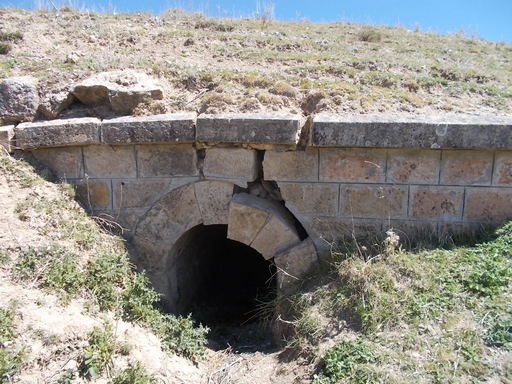 All indications were that they would be able to open the viaduct in the early days of 1906 and therefore the line. However, in the early days of 1905 the eastern span (the Baza side), as a result of the filtration of groundwater, started to suffer from subsidence and inclination of the support. The movement caused a subsidence of the pillar of 40cm. The beams started to be embedded in the base which required urgent resolutions to prevent the total collapse of the viaduct.
All indications were that they would be able to open the viaduct in the early days of 1906 and therefore the line. However, in the early days of 1905 the eastern span (the Baza side), as a result of the filtration of groundwater, started to suffer from subsidence and inclination of the support. The movement caused a subsidence of the pillar of 40cm. The beams started to be embedded in the base which required urgent resolutions to prevent the total collapse of the viaduct.
Even though the subsidence of the viaduct was serious, there were solutions put in place in the following months so as to keep the line active. However, in spite of huge attemps to resolve the problem, there was no solution: the weight of the Baza side of the viaduct continued to cause subsidence of the base. In this way, the weight of the span put a pressure on the base that it couldn't support.
Thus, they urgently put extensive renovations into effect. The final technical report regarding the footings would be included in the promised project, whose report was approved by Rafael de la Escosura, with great urgency. They then decided on strategies for works on the bases to resolve the problems as well as excavating so as to get a better idea of what they faced.
In these studies they found layers of clay and sand over a calciferous loam.
As an interim measure, the report suggested the construction of a deeper base with a plate at its base to resist further subsidence. However, they didn't arrange for any systems of drainage. They were confident in the quality of the new materials in use for the construction of the new part of the base which would resolve the problem.
Unfortunately, it became obvious that these methods were ineffective. This was due to the infiltration of water in the whole area.
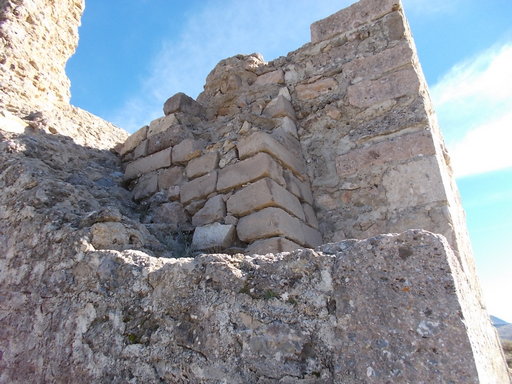 In the end, it became necessary, as a matter of urgency before the viaduct collapsed, to reinforce the base whilst deconstructing the viaduct at the Baza end and supporting it with wooden scaffolding.
In the end, it became necessary, as a matter of urgency before the viaduct collapsed, to reinforce the base whilst deconstructing the viaduct at the Baza end and supporting it with wooden scaffolding.
At this time they cleared all of the land under the viaduct and installed pumps to remove the water from the land that had filtered through the embankment. The filtration of water also came from the irrigation canals Acequia de la Mujer and Acequia de Almaraz which passed behind and above the embankment.
Hardly a week had passed, when there were a huge number of workers on site, that the pillar was demolished. The enormous mass of the embankment then slid down the slope making a track and the irrigation canal Acequia de la Mujer unusable.
Fortunately, this didn't cause any serious problem as the span was supported by wooden beams and all went well with the re-construction which was executed rapidly under the engineer Basinsky, the head of works of the Guadix-Baza line. In early February they had verified the demolition and in the four months that followed there was constructed a new base.
Sadly, all this work was useless, making it impossible to save the viaduct. In June of 1906, the recently finished support started leaning again. To prevent more problems, the technicians of the company said that the viaduct wasn't viable. Thus, the project was abandoned and a much smaller alternative was considered about 600 metres closer to Gor. This was to cost the company about 1 million pesetas in the construction of a new bridge and 1.5km of extra track.
Surprisingly, considering the problems that the viaduct had, it was used for six years after its construction.
The slow death
 In 1906, the Guadix-Baza line was finished. As a temporary measure, a Royal Order of 7th January 1907 required that passengers detrain and cross the viaduct on foot due to the risk of collapse. By May of 1907, plans for the alternative route were published by Rafael de la Escosura. To open the line he applied to the authorities to open the viaduct provisionally: "the tests that they are doing...indicate that there is a great probability that the base that has moved has now come to a permanent stop, meaning that it can be used as a support for the viaduct." Believing that they could save the viaduct, they proposed a provisional solution - a scaffold of wooden supports under the 12m span.
In 1906, the Guadix-Baza line was finished. As a temporary measure, a Royal Order of 7th January 1907 required that passengers detrain and cross the viaduct on foot due to the risk of collapse. By May of 1907, plans for the alternative route were published by Rafael de la Escosura. To open the line he applied to the authorities to open the viaduct provisionally: "the tests that they are doing...indicate that there is a great probability that the base that has moved has now come to a permanent stop, meaning that it can be used as a support for the viaduct." Believing that they could save the viaduct, they proposed a provisional solution - a scaffold of wooden supports under the 12m span.
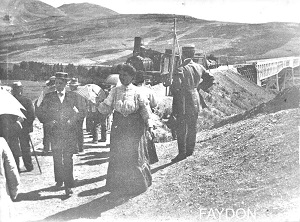 But after all, he did nothing and the base, without stabilization, continued to move. In the July of 1909 the engineer Martin Gil, inspector of the Fourth Division of the railway made the statement regarding: "The critical conditions of the instability of the bridge" stating that the base had "moved longditudinally along the track 3.6m towards the pillars and water underneath caused a subsidence of 0.5m to date and an inclination from vertical of 0.7 and 0.25m". The viaduct continued to be precarious because "a demolition team of masons were occupied with breaking up the base so that the span doesn't put unnecessary force on the pillars", even though the the upper beams were already "outside of the vertical".
But after all, he did nothing and the base, without stabilization, continued to move. In the July of 1909 the engineer Martin Gil, inspector of the Fourth Division of the railway made the statement regarding: "The critical conditions of the instability of the bridge" stating that the base had "moved longditudinally along the track 3.6m towards the pillars and water underneath caused a subsidence of 0.5m to date and an inclination from vertical of 0.7 and 0.25m". The viaduct continued to be precarious because "a demolition team of masons were occupied with breaking up the base so that the span doesn't put unnecessary force on the pillars", even though the the upper beams were already "outside of the vertical".
Due to the seriousness of the situation, the technician urged that an alternative route should be sought, obviating the need to repair the viaduct. On the other hand, he made clear that the Compañia de Caminos de Hierro de Sur de España was guilty of doing nothing in the preceding years.
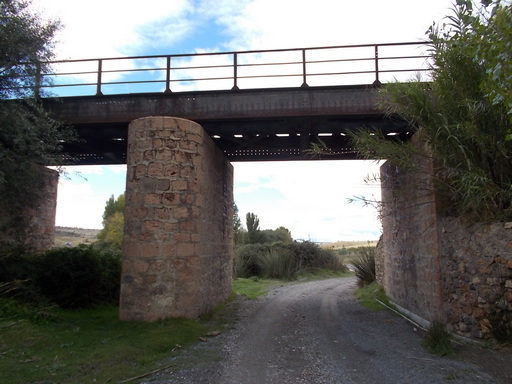 This company decided, at the end of 1910, to maintain their intention to repair the viaduct. In the project signed by Silvestre Fernández de la Somera (the technical director) it was proposed the demolition of part of the viaduct and the addition of a new part with new dimensions to counteract the pressure of the embankment. The works for this were authorized a few months later by the company, and these can be seen in real life nowadays.
This company decided, at the end of 1910, to maintain their intention to repair the viaduct. In the project signed by Silvestre Fernández de la Somera (the technical director) it was proposed the demolition of part of the viaduct and the addition of a new part with new dimensions to counteract the pressure of the embankment. The works for this were authorized a few months later by the company, and these can be seen in real life nowadays.
However, these measures failed to stabilize the support. After this it was decided to seek an alternative route, constructing a bridge upstream. Having learnt their lesson from so many problems, the company didn't want to take any further risks so they adopted a simple design of a bridge of straight beams, in three spans of 6m, on strong stonework supports, which was constructed in 1912. At the end of this year it was accepted by the administration, and was put immediately into service.
The trains stopped crossing the viaduct definitively in 1913, the day that the company communicated to the 4th Division of the Railways the "normalization of the service via the diversion through Gor". The abandoned viaduct was certified by the Administration in 1921.
A new life in Dúrcal (1923-1974).
After its unlucky experiences in Gor, the viaduct started a new life on a different railway line in the province of Granada where it found its new home in Dúrcal as part of the tramway 'Sociedad Anónima de Tranvías Eléctricos de Granada'. It remained in use as a railway viaduct for a further 50 years.
 At the beginning of the 20th century, at the peak of the farming industry, there was the stimulation of modernization in the province, including the advancement of transport networks. Granada had had a network of tramlines since 1903, when as a result of the Zaragozan initiative Nicolás Escoriaza constructed 'Sociedad Anónima de Tranvías Eléctricos de Granada'. After many frustrations, the company built the first (electrified) lines in the capital.
At the beginning of the 20th century, at the peak of the farming industry, there was the stimulation of modernization in the province, including the advancement of transport networks. Granada had had a network of tramlines since 1903, when as a result of the Zaragozan initiative Nicolás Escoriaza constructed 'Sociedad Anónima de Tranvías Eléctricos de Granada'. After many frustrations, the company built the first (electrified) lines in the capital.
In the first two decades of the 20th century, the Granadan tram network grew exponentially, adding new lines that connected the city to its environs. The networks were so successful that it was decided to extend the network to outlying towns and even to the south of the province of Jaén and to the south coast of Granada.
The route to Jaén was never built, but the route to the Mediterranean was built quickly. In 1920, animated by the opening of the route to Motril, the company agreed to "the construction of an electric railway from Alhendín to Dúrcal, extending the line from Granada to Alhendin". In a later phase it was proposed that there would be constructed a secondary line which would link from there to Motril (even though this connection was by cablecar). This route didn't present any huge complications. The only problem was crossing Río Dúrcal, which required a viaduct of some 200m. With this in mind, the idea was proposed of purchasing the Gor Viaduct which at this time had been abandoned for a decade. Without doubt, this was propounded by Nicolás Escoriaza, who had a large number of shares in the Granadan tram company as well as in the Baza-Guadix Railway.
The deconstruction, transport of the parts and re-construction in Dúrcal was charged to a German specialist company, Dortmunder Union. It was necessary to bring a specialist crane by ship from Germany which was shipped through Almería port and was later transported to Gor by rail. Once disassembled, the parts of the viaduct were transported by lorry to Dúrcal. Once there, the re-construction of the viaduct took until 18th July 1923, the day that the viaduct was inaugurated.
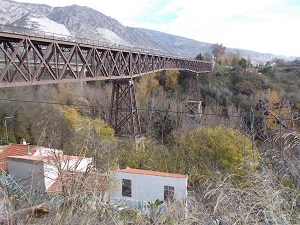 In its new home, the viaduct was a little shorter (200m as opposed to 210m). As with its erection in Gor, the centre span was fitted to mate up with the auxiliary spans.
In its new home, the viaduct was a little shorter (200m as opposed to 210m). As with its erection in Gor, the centre span was fitted to mate up with the auxiliary spans.
Also, it was necessary to enlarge the pillars, which needed to be much taller than those of Gor, and which were constructed of reinforced concrete. The Granada pier (the Baza one when in Gor) was replaced with a brick arch. This wasn't done because of the problems in Gor, but to allow the passage of the Granada-Motril road (however, it may have been a good solution to the problems in Gor).
Since then, it was in use without even the most minor of problems.
The viaduct today
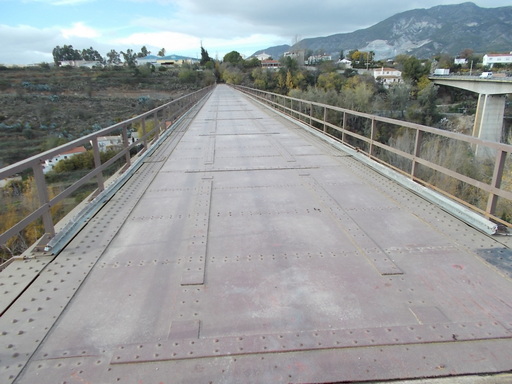 After 1974, when the tramline closed, the viaduct was converted to a pedestrian bridge which is still there today and is a monument of much interest in the town. It is truly an impressive sight and its construction must have given many headaches for the German team.
After 1974, when the tramline closed, the viaduct was converted to a pedestrian bridge which is still there today and is a monument of much interest in the town. It is truly an impressive sight and its construction must have given many headaches for the German team.
A FINAL NOTE: In the 20/20 vision of hindsight, it is hard to see why the company didn't construct the bridge on the site where the 'new' iron bridge now stands. It would have only required an extra 1.5km of track and would have been much more economical to build. In addition, Gor Station would have only been 1km from the town itself instead of 3.7km. We will never know why they thought that a 210m viaduct built on soft ground would be better than a 25 metre iron bridge.


